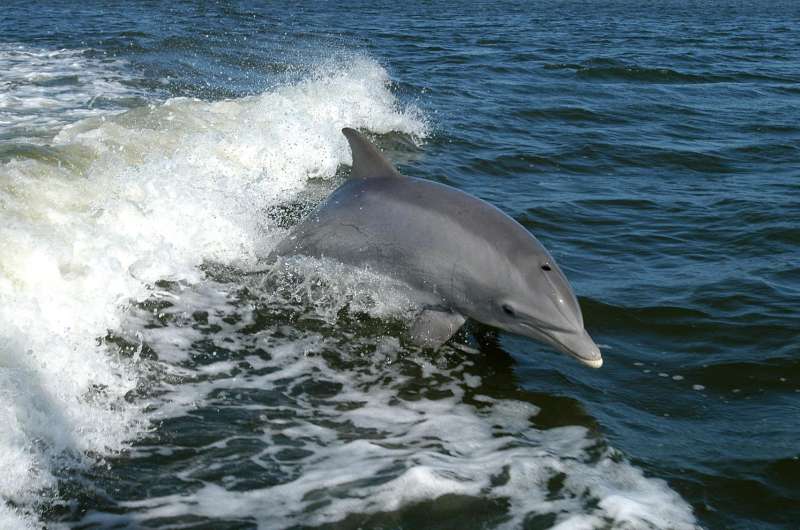December 21, 2016 report
Human interactions with dolphins proving to be dangerous to the marine animals

(Phys.org)—A team of researchers with members from institutions in Australia, the U.S. and the U.K. has found evidence that suggests increased dolphin familiarity with humans has led to an increase in injury and death to the marine mammals. In their paper published in the journal Royal Society Open Science, the team describes their study and why they believe current trends could lead to a drop in the dolphin population along the Florida coast. In a related paper in the same journal, a team of researchers affiliated with several institutions in Australia reports on an unusual mortality event (UME) involving cases of morbillivirus in several types of dolphins and offer a theory regarding why it may have occurred.
In the first study, the researchers used a database that stored information describing interactions between humans and dolphins near Sarasota Bay in Florida over the years 1993 to 2014. In all, they studied data on 32,000 dolphin sightings that involved approximately 1,000 dolphins. Dolphins in the database were classified as being "conditioned" if they behaved in ways that suggested they actively sought out humans for food. They noted that during the initial years of the study, only 25 of the dolphins were conditioned—that number jumped to 190 by the final study year, suggesting a trend toward more dolphins becoming conditioned. The researchers also found that those dolphins defined as conditioned experienced higher mortality rates than other dolphins, further suggesting that interactions with humans were causing some to be killed. The researchers noted this might be due to dolphins being struck by high-speed boats or propellers or by becoming entangled in nets. They noted also that 75 of the dolphins under study showed signs of human-related injuries.
In the second story, the research team in Australia found that a UME had occurred off the South Australia coast in 2013 involving multiple types of dolphins being infected with the morbillivirus—a relative of the virus that causes measles in humans. Approximately 50 dolphins died during the event, though the researchers do not know how much of an impact it had on the population as a whole. They noted that the UME occurred during a period of increased water temperatures and a diatom bloom that also coincided with a large fish die-off, which suggests the likely cause of the unusual event was the increase in marine temperature.
More information: 1. Fredrik Christiansen et al. Food provisioning increases the risk of injury in a long-lived marine top predator, Royal Society Open Science (2016). DOI: 10.1098/rsos.160560
Abstract
Food provisioning of wildlife is a major concern for management and conservation agencies worldwide because it encourages unnatural behaviours in wild animals and increases each individual's risk for injury and death. Here we investigate the contributing factors and potential fitness consequences of a recent increase in the frequency of human interactions with common bottlenose dolphins (Tursiops truncatus) in Sarasota Bay, Florida. A rising proportion of the local long-term resident dolphin community is becoming conditioned to human interactions through direct and indirect food provisioning. We investigate variables that are affecting conditioning and if the presence of human-induced injuries is higher for conditioned versus unconditioned dolphins. Using the most comprehensive long-term dataset available for a free-ranging bottlenose dolphin population (more than 45 years; more than 32 000 dolphin group sightings; more than 1100 individuals), we found that the association with already conditioned animals strongly affected the probability of dolphins becoming conditioned to human interactions, confirming earlier findings that conditioning is partly a learned behaviour. More importantly, we found that conditioned dolphins were more likely to be injured by human interactions when compared with unconditioned animals. This is alarming, as conditioning could lead to a decrease in survival, which could have population-level consequences. We did not find a significant relationship between human exposure or natural prey availability and the probability of dolphins becoming conditioned. This could be due to low sample size or insufficient spatio-temporal resolution in the available data. Our findings show that wildlife provisioning may lead to a decrease in survival, which could ultimately affect population dynamics.
2. C. M. Kemper et al. Morbillivirus-associated unusual mortality event in South Australian bottlenose dolphins is largest reported for the Southern Hemisphere, Royal Society Open Science (2016). DOI: 10.1098/rsos.160838
Abstract
Cases of morbillivirus have been recorded in the Southern Hemisphere but have not been linked to significant marine mammal mortality. Post-mortems were conducted on 58 carcasses (44 Indo-Pacific bottlenose dolphins, two common bottlenose dolphins, 12 short-beaked common dolphins) from South Australia during 2005–2013, including an unusual mortality event (UME) in St Vincent Gulf Bioregion (SVG) during 2013. Diagnostic pathology, circumstance of death, body condition, age and stomach contents were documented for Indo-Pacific bottlenose dolphins. At least 50 dolphins died during the UME, 41 were Indo-Pacific bottlenose dolphins and most were young. The UME lasted about seven months and had two peaks, the first being the largest. Effect on the population is unknown. Diagnostic testing for morbillivirus was conducted on 57 carcasses, with evidence for infection in all species during 2011–2013. All tested UME bottlenose dolphins were positive for cetacean morbillivirus (CeMV), and the pathology included interstitial pneumonia, lymphoid depletion and syncytia. Concurrent pathologies, including lung parasite and fungal infections, and severe cutaneous bruising were observed in many dolphins. The event coincided with elevated water temperatures, a diatom bloom and significant fish die-offs. We conclude that the cause for the UME was multifactorial and that CeMV was a major contributor.
Journal information: Royal Society Open Science
© 2016 Phys.org

















